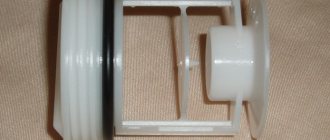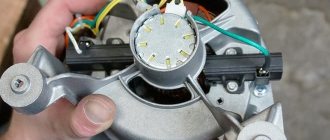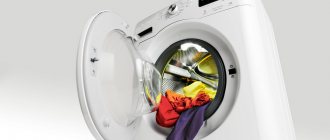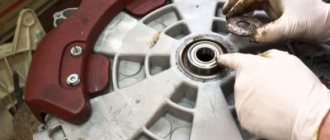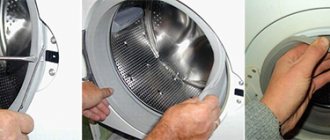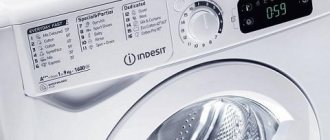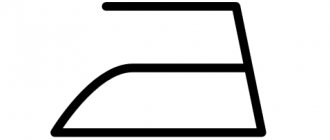Signs that cleaning is needed
It is necessary to immediately begin cleaning the system if the following problems are observed:
- The laundry rinsing function has stopped working;
- when you try to put the machine on spin, it turns off or is blocked;
- The water drain does not work well or is completely turned off;
- a puddle of water appeared under the machine;
- the unit has completely failed, this happens rarely, more often when the filter is clogged with large debris.
In the instructions or documents for the washing machine, the drain filter may also be called drainage or garbage.
Where is?
Its location depends on the brand of washing machine. Below is a list with the most popular brands and locations of the required part.
| Electrolux and Zanussi top loading | Washing machine drum rib. Removable from the inside. |
| Atlant | Bottom right corner, hidden behind a small hatch |
| Top-loading machines (except Electrolux and Zanussi) | The lower left corner is usually behind the plastic panel |
| Samsung | Lower right corner, usually hidden behind a plastic panel, but there may also be a small hatch |
| Classic washing machines Electrolux and Zanussi | Lower right corner, covered with a plastic false panel |
| Bosch and Siemens | Lower right corner, covered with a plastic false panel or small hatch |
| Candy | Lower left corner, hidden behind a metal hatch |
| LG | Lower left corner behind plastic or metal hatch |
| Indesit | Behind the lower removable panel on the right |
| Ariston | Behind the lower removable panel on the right or behind the plastic hatch |
Where is the problem?
It can be difficult for a simple consumer to determine the location of the filter. Following the usual logic, the owner tries to find the required element in the immediate vicinity of the water supply system, or with good reason believes that the drain point requires cleaning.
Let us immediately note that each of these decisions turns out to be correct. The design features of the Atlant washing machine involve cleaning the water during its intake and at the end of the washing process, and our model has a pair of filters - inlet and drain.
Some washing machines are equipped with devices for additional liquid purification, but they are installed not in the factory, but in service centers according to individual user orders.
Stages of work
Before directly cleaning the filter, preparatory work is required. It is especially important to pay attention to this point for residents of apartment buildings, since there is a risk of flooding of neighbors.
- First you need to prepare a deep container for draining water and a well-absorbing rag. They cover the washing machine with it, some of the rags are placed under the bottom of the unit. Even after completely draining the water from the drum, a small amount of water remains inside; placing a rag will protect it from flooding.
- Disconnect the drain hose and drain the water from the washing machine through it. This can also be done by loosening the connection between the drain filter and the pump system. Some models have built-in emergency hoses, in which case the water is drained through them.
- Only after this is it possible to unscrew the seat cover. The filter is carefully removed from the system; it is recommended to ensure that it comes out freely and does not catch anything. Sometimes large debris prevents the part from coming out, in which case these fractions should first be moved with objects of suitable size: a screwdriver, knife or tweezers.
- After removing the filter, it is cleaned using any chosen method; the place where the part is installed must be cleaned. Additionally, it is recommended to carry out work to remove limescale, protect against mold and unpleasant odors.
- At the end, the filter is carefully installed in place. It is important to secure it and the protective cover tightly to avoid leaks during operation of the equipment.
Expert opinion
Torsunov Pavel Maksimovich
Before you begin any manipulations with the washing machine, you must completely disconnect it. Even when the power is turned off, there are nodes that can give an electric shock even if you touch them minimally.
What to do if the drain filter cannot be removed
If you cannot unscrew the drain filter with normal force, then it is better to disassemble the entire pump unit. The reason for its blockage can also be an object that has fallen into its cavity, and without removing the pump, it will not be possible to remove it from there. To troubleshoot the problem you must:
- Disconnect the washing machine from the power supply and water supply;
- Remove protective decorative elements and provide access to the drain pump housing;
- Unscrew all the bolts, nuts and screws that secure the drain pipe and pump to the body of the washing unit;
- Loosen and push back the clamps securing the drain pipe and drain hose to the pump body;
- Remove the pipe and hose;
- Inspect the filter cavity through the pipes, and if there are foreign objects, remove them.
In order to remove a stuck object, sometimes it is enough to simply shake the pump, and the button or paper clip stuck there will fall out through the hole in the nozzle. Otherwise, you can use a screwdriver or tweezers.
Why can’t I unscrew and remove the filter?
The main enemy of all mechanical parts of a washing machine is water with detergents and salts dissolved in it. During operation, under the influence of temperature, these substances are deposited on the walls of all elements involved in the washing process. This, in turn, disrupts their work. If the filter elements have not been unscrewed for a long time, salts deposited on the threads of the filter housing and drain pipe can cause them to block. The part may also not unscrew if there is a foreign object between its body and the impeller.
All the ways to open and remove the drain filter
To remove the drain filter from the drain pipe, sometimes you can do without removing the pump. If the filter can be unscrewed at least half a turn, you should try to unscrew it “back and forth” with gentle movements. If the body is blocked by scale, then it is destroyed, and then this method works. If some “trifle” gets in the way, its position in the body may change and the part can be unscrewed.
Cleaning the shot
After removing the drain filter, it is recommended to first rinse it under running water. If there are buttons, pieces of fabric, paper or other debris inside, it must be removed.
Since there will be a large amount of soap and limescale on the part, it needs to be removed; ordinary water will not cope with this. To do this, take a good sponge with an abrasive layer. For better cleaning, the sponge can be soaked in any anti-scale agent; a solution for cleaning a bathroom or toilet is suitable. After washing the filter, rinse it again with warm water.
After this, be sure to check the drain pump where the filter was located. To do this, just shine a flashlight inside and, if necessary, remove any debris in the system. After this, the part is put in place, secured, and the machine is turned on to check for leaks.
Although experts recommend cleaning the drain filter every few months, when washing duvets, pillows and similar items, it is better to open the drain system immediately after washing and clean it. There will definitely be a large amount of fluff, wool and feathers inside.
Cleaning without removal
If you do not want to remove the part from the system, you can try cleaning it without removing it. This can be done in several ways.
Are you cleaning your washing machine drain filter?
Of course! Rarely, but it happens
Lemon acid
To clean the filter using this substance, you will need:
- Open the container for the powder and pour 50-100 g of citric acid into it; the greater the likelihood of contamination, the more substance we add.
- Having closed the container, select a mode with a minimum temperature of 60 degrees, with heavy contamination - 90 degrees.
- After completing the cycle, put the washing machine on a rinse cycle to remove any remaining citric acid.
- If after one cycle it was not possible to remove all the debris, repeat the cleaning until it is completely clean, this will be visible by the transparency of the water inside the washing drum.
Table soda
This substance allows you to clean not only debris, but also remove mold that forms not only on the filter, but also inside the hoses.
To clean, you will need to do the following:
- 50 g of soda should be poured inside the washing drum and into the container for washing powder; you can combine the substance in equal proportions with the powder, so the result will be better;
- turn on the maximum temperature mode and wash for at least 2 hours;
- after completing the cycle, you should wipe all open parts of the washing machine, including the powder container;
- In case of heavy contamination, the procedure should be repeated one more time.
Table vinegar
When using the substance, protect your eyes and respiratory system. For cleaning, vinegar with a 9% concentration is used.
- To clean the drain filter of the entire washing machine system, 200-250 ml of vinegar must be poured into the washing powder tray.
- We turn on the washing mode at 60-90 degrees, which lasts at least 2 hours, but not manually.
- After one hour of washing, turn off the machine and leave it for 1-2 hours to settle. After this, the washing machine starts again.
- If necessary, several cleaning cycles are carried out.
After using vinegar, it is recommended to remove the filter in any case. Acetic acid perfectly removes dirt from inside the system, so there is a high risk that the filter will become even more dirty if a lot of debris has accumulated inside the machine itself. After that, it is recommended to turn on the machine again with a small portion of powder, soda, vinegar or citric acid.
Bleach or any product containing high chlorine
When working with such substances, you should be as careful as possible, avoiding contact with eyes, respiratory organs and skin.
- Pour 20-50 ml of white into the tray for washing powder and turn on the mode with maximum temperature.
- After 15 minutes of operation of the washing machine, pause and leave everything for 1-2 hours.
- After this time, we restart the system for 40-60 minutes. After completing the cycle, add a little of any suitable cleaning agent to the powder container and run the machine at 1-1.5 to eliminate the pungent odor of chlorine.
These methods are more preventative, as they do not allow large debris to be removed. They are recommended to be combined with the main one to achieve ideal cleansing of the entire system.
Ways to clean the drain filter in a Samsung washing machine
> Technique >
14.01.2020
In order for a Samsung washing machine to work efficiently, it is necessary to monitor its condition and perform timely maintenance. One of its types is regular filter cleaning. In order to ensure trouble-free operation of the device throughout its entire service life, the owner must know how to clean the drain filter in a Samsung washing machine.
Samsung washing machine drain filter: description
During operation, the water in the Samsung washing machine becomes dirty, and foreign objects also get into it: threads, hair, buttons, coins and others. They gradually accumulate, preventing the circulation and drainage of water. The filter purifies water by trapping contaminants and foreign objects.
Over time, it becomes clogged, slowing down the machine and reducing the quality of the wash. The rate at which debris settles depends not only on the operating time, but also on what items are washed.
The Samsung washing machine has two filters. One of them purifies the water supplied for washing (fill water). The other is designed to filter water during circulation inside the washer and when draining (drain filter). When the machine’s operation ends, all the water from the tank is drained, but a small amount of liquid remains in the filter and pipes. This must be kept in mind when removing the filter.
Signs you need cleaning
You can know that it is time for cleaning by the appearance of the following signs:
- The machine's diagnostic system detects the presence of unidentified faults.
- Draining is performed with less intensity than usual.
- The work is blocked for an unknown reason.
- Regular failures occur during rinsing.
- When spinning occurs, the operation stops. However, the reason for the shutdown cannot be determined.
- Washed laundry develops an unpleasant odor.
If there was a situation in which one or more symptoms from the list above occurred, then it is necessary to monitor the condition of the drain filter and, if necessary, clean it.
Types of blockages
Blockages can be divided into two types:
- Mechanical include the ingress of foreign objects. Often clothes are put into the wash with small items left in their pockets. Sometimes buttons and decorative items are used that easily come off and end up in the drain.
- This category also includes lint, hair, and pet hair.
It is impossible to completely stop filter contamination, however, by following simple rules, you can significantly reduce its speed.
Design features and location
The main part of the filter is a mesh, which is secured in a plastic mounting structure. The filter screws into the hole, which is located on the lower right side of the front panel of the washing machine. To see it you need to remove the protective panel.
Filtration principle
During draining or circulation, water is passed through a drain filter mesh. At the same time, small objects linger on it and impede the passage of water.
After finishing the wash, the accumulated dirt remains in place. Thus, filter contamination increases over time.
If you do not clean it in time, the water will pass through the mesh more and more slowly. This can cause increased equipment wear and malfunctions. To avoid this, it is necessary to periodically clean the filter.
Frequency of cleaning the filter element
While using the washing machine, you need to periodically clean it. The time when such a need arises depends on the intensity of use of the technology. To determine when to clean, the following methods can be used:
- Monitor for signs of contamination and carry out the procedure as necessary.
- Clean periodically in accordance with the manufacturer's recommendations.
- Carry out the procedure according to your schedule, adjusting it as necessary.
Based on the condition of the filter during cleaning, you can see how often or less often it needs to be done. In most cases, doing this every two months is sufficient.
What means are used
After removing the filter, it must be cleaned. This can be done conveniently by rinsing it with warm water under the tap. You can scrub it with the soft side of a washcloth. It is necessary to clean not only the filter itself, but also the place where it is inserted. Wipe it thoroughly with a slightly damp soft sponge.
How to disassemble and clean the filter
To clean the drain filter, you must perform the following steps:
- Before starting work, you need to disconnect the machine from the power supply and turn off the water supply.
- Before starting the procedure, it is recommended to drain all the water. It must be remembered that some of it will remain in the pipes and may leak onto the floor during operation. To avoid this, place a rag or flat container under the place where the filter is located.
- At the bottom of the front panel of the washer there is a protective panel that covers the drain filter. It is secured with latches. This panel needs to be removed. You can use a screwdriver or knife to open the latches. In some Samsung machines this can be easily done by hand without using tools.
- Underneath it, on the right side, you can see the round cover from the drain filter. To remove the filter, you need to unscrew it. This must be done in a counterclockwise direction, and then the part is pulled towards itself.
- This part needs to be cleaned by removing any debris that has accumulated here. Then it is thoroughly washed. It is not recommended to use strong cleaning agents to avoid damage. The use of hot water is prohibited, as this may cause the part to become deformed and stop performing its functions. During cleaning, care must be taken not to damage the rubber seal.
- The hole in which the filter was placed must be carefully cleaned. This must be done carefully. But without unnecessary effort in order not to cause damage.
- The filter is put back. Then install the protective panel in its original place.
After installing the filter in its original place, you need to move it slightly. To make sure it is firmly attached.
Tips and tricks for use
To ensure that the filter becomes dirty more slowly, you need to pay attention to the following:
- When washing fabrics with lint, the filter will become more clogged. To avoid this, such items can be washed by placing them in a fabric bag.
- If products made from natural fluff (for example, pillows) or fur (including children's blankets or toys) were loaded into the washing machine, it is recommended to clean it after each wash.
- You need to check your clothing pockets for forgotten small items: money, matches, or the like. It is recommended to remove pieces of thread or hair stuck to it from clothing.
- You need to check how tightly buttons or accessories are sewn to clothing. It is necessary to take into account the possibility that they may come off during the washing process. Products that have small parts that can come off are recommended to be washed in fabric bags.
If you follow these tips, you can significantly reduce the degree of filter contamination.
Questions and answers
Does the number of times you clean the drain filter depend on the brand of washing machine?
No. But the older the device, the more often you will need to care for it.
How often should you clean the drain filter in your washing machine?
Such work must be carried out every six months. If the washing machine is used several times a week, cleaning is carried out every three months.
Will citric acid harm the drain system?
No, it is even used in dishwashers. The main thing is to choose the appropriate temperature regime.
Isn’t it better to turn to a specialist for such work?
This amount of work is quite within the capabilities of any person, so it makes sense to call for repairs only if for some reason you cannot remove the filter or its cover.
Is it possible to use several substances at once when cleaning on one day, but in different cycles?
Of course you can. But strictly in different cycles, so as not to provoke the release of toxic fumes into the air.
